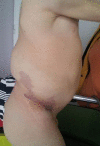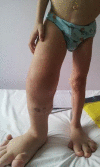Proteus Syndrome: a difficult diagnosis and management plan
- PMID: 25713623
- PMCID: PMC4316140
Proteus Syndrome: a difficult diagnosis and management plan
Abstract
Rationale: Proteus Syndrome (PS) is an extremely rare congenital pathology that causes overgrowth of multiple tissues, in particular bone and fat, following a mosaic pattern. The estimated incidence is of less than 1 per 1,000.000 live births and represents a significant challenge to the pediatric and orthopedic surgeons in order to establish a diagnosis and to elaborate a management plan.
Objectives: We had the opportunity of treating many children who were afflicted by overgrowth syndromes and have been previously misdiagnosed as Proteus Syndrome in our department of pediatric and orthopedic surgery of "Maria Sklodowska Curie" Clinical Emergency Hospital for Children. This study helped us develop a diagnostic for these patients and report the first case of a confirmed PS in Romania.
Methods and results: We report the case of a 5-year-old white male who is in the attention of the clinic since birth. He presented with multiple overgrowth bone segments, fatty subcutaneous or intraabdominal tumors and other connective tissues abnormalities. All the tests performed confirmed the diagnosis of PS at the age of 4 and the management is still to be decided.
Discussions: We followed the latest diagnostic indications and the patient fulfilled the general and specific criteria. The treatment is still in progress and it represents a challenge for the multidisciplinary medical team.
Keywords: Proteus syndrome; cerebriform lesion; connective tissues abnormalities; overgrowth.
Figures
References
-
- Lublin M, Schwartzentruber DJ, Lukish J, Chester C, Biesecker LG, Newman KD. Principles for the Surgical Management of Patients With Proteus Syndrome and Patients With Overgrowth Not Meeting Proteus Criteria. Journal of Pediatric Surgery. 2002;37, 7:1013–1020. - PubMed
-
- Cohen MM Jr. Proteus Syndrome: An Update. American Journal of Medical Genetics. 2005;Part C, 137C:38–52. - PubMed
-
- Furquim I, Honjo R, Bae R, Andrade W, Santos M, Tannuri U, Kima C. Proteus syndrome: report of a case with recurrent abdominal lipomatosis. Journal of Pediatric Surgery. 2009;44 - PubMed
-
- Panteliadis C, Benjamin R, Cremer HJ, Hagel C, Omran H. Proteus Syndrome. Neurocutaneous Disorders Hemangiomas. 2007:115–117.
-
- Jamis-Dow CA, Turner J, Biesecker LG, Choyke PL. Radiologic Manifestations of Proteus Syndrome. Radio Graphics. 2004;24:1051–1068. - PubMed
Publication types
MeSH terms
LinkOut - more resources
Full Text Sources
Other Literature Sources




